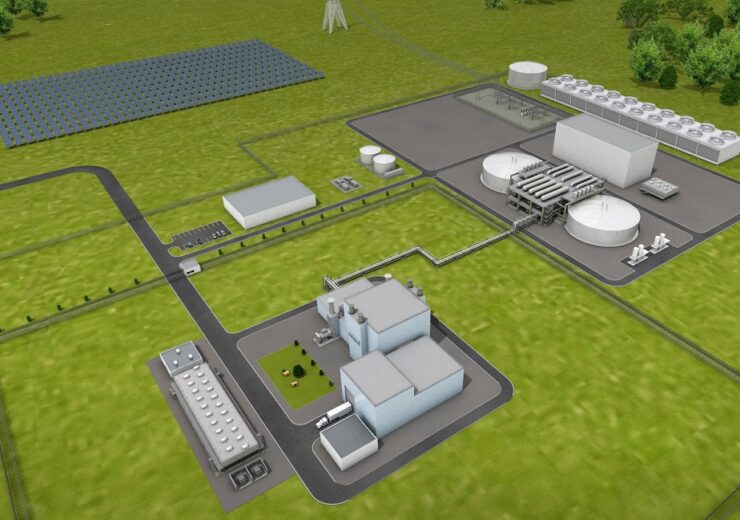A nuclear reactor demonstration project is intended to prove out the new technology’s design, licensing, construction and operational features

Visualisations of the Natrium sodium cooled fast reactor, with molten salt storage. (Credit: TerraPower, LLC.)
While global energy demand declined slightly in 2020 due to the Covid-19 pandemic, the International Energy Agency expects demand to grow in 2021 due to the recovery of the global economy. Looking ahead, the US Energy Information Administration estimates world energy consumption will increase nearly 50% by 2050.
This points to the need for continued innovation and growth in clean energy sources to both meet this demand and combat and mitigate climate change. Advanced nuclear energy technologies will help achieve these goals by fulfilling the world’s increasing energy needs with clean, reliable energy that can power homes and businesses 24/7.
Since its founding [by Bill Gates and a group of “like-minded visionaries”], TerraPower has been focused on developing advanced nuclear energy [including the Travelling Wave concept and molten chloride fast reactor technology] to meet growing electricity needs, mitigate climate change and lift billions out of poverty. Today, the company is working with its partners to build the first Natrium™ (sodium-cooled fast reactor) plant at a retiring coal facility in Wyoming. These efforts to demonstrate the Natrium reactor, a TerraPower and GE-Hitachi technology [building on GE-Hitachi’s PRISM concept] are underway as part of the US Department of Energy’s (DOE) Advanced Reactor Demonstration Program (ARDP).
A nuclear reactor demonstration project is intended to prove out the new technology’s design, licensing, construction and operational features. The ARDP is a precedent-setting, public-private partnership to support such demonstration efforts. Notably, sodium-cooled fast reactors, like the Natrium reactor, have the highest technology readiness levels of any advanced non-light water reactor. The goal of demonstrating the Natrium technology is to enable the commercialisation of this new source of abundant and affordable clean energy in time to help meet climate goals.
The demonstration project will feature a 345 MWe reactor with a molten-salt-based energy storage system. The storage system, similar to those employed in solar applications, provides flexible generation capability and can boost the system’s output up to 500 MWe of power for long durations (over five and a half hours when needed). At the end of the project, the Natrium demonstration will be a Nuclear Regulatory Commission (NRC)-licensed, grid-scale reactor entering commercial service.
Over the past century, technology innovation and US economic prosperity have been mutually dependent. Research and development are necessary to create technologies that have market potential and can improve public welfare.
In the advanced nuclear sector, the successful development and commercialisation of a reactor rely heavily on government policy and regulation. As a result, government involvement helps to stimulate innovation and supports continued private investment.
Advanced reactor demonstrations build on a long history of public- and private-sector co-operation in the United States. Such efforts resulted in the development of railroads, the internet, the space programme and even the light water reactor technology used at today’s nuclear energy plants.
The Natrium demonstration project will follow a seven-year schedule as mandated by Congress. The project includes elements related to plant design, methods development, NRC licensing, equipment testing and qualification, procurement, construction, operating programme development, fuel development and supply, and program management.
Early in the process, the Natrium team will select the site for the demonstration project, advance the plant design and submit a construction permit application to the NRC. In parallel, the team will test fuel and equipment, and work with industry to secure the high-assay, low-enriched uranium (HALEU), metal fuel and equipment supplies needed for the demonstration project.
Once the construction permit is obtained, the team will proceed with the construction phase of the project. They will also fabricate the fuel and train operating staff while the NRC reviews the operating license application. Following issuance of the operating licence, the team will proceed with fuel load and begin operations.

The Natrium demonstration plant will be a fully functioning commercial power plant and, upon the demonstration project completion, the Natrium team will have established the infrastructure needed for a future fleet of plants across the United States and even around the world.
Importantly, the Natrium demonstration project will benefit from a skilled and motivated workforce in Wyoming.
As energy demand continues to grow and leaders at all levels of government continue to set ambitious emissions-reduction goals, it is abundantly clear that the world needs more reliable, carbon-free energy. Advanced reactors, like the Natrium technology, are uniquely positioned to meet this need.
Demonstrating the Natrium reactor is a crucial part of commercialising this technology and realising its full potential to meet growing energy demand while combating climate change.
This article first appeared in Modern Power Systems magazine.
